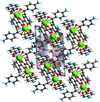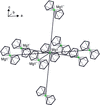issue contents
March 2022 issue

Cover illustration: This issue contains an article that highlights just two of the things for which former Acta E Co-Editor Jerry P. Jasinski will always be remembered by the crystallographic community: his love for teaching and for scientific collaboration. In the paper by Addison et al., the structures of four Co complexes with pyridylethyl-derived diazacycloalkanes are presented. The Co atoms display tetrahedral and trigonal–bipyramidal coordination. The use of Vis and NIR electronic spectra to differentiate these coordination geometries is presented. Solvophobicity of the Cl atoms present in the coordination sphere of Co plays a role in the different coordination geometries. The structures are sustained by weak, non-bonding interactions. Mono and di-nuclearity are also displayed by these compounds and the magnetic behaviour is attributed to zero-field splitting of the Co ion since there is no evidence of SMM behaviour. See: Addison, Jaworski, Jasinski, Turnbull, Xiao, Zeller, O'Connor & Brayman [Acta Cryst. (2022). E78, 235–243].
Jerry P. Jasinski tribute


research communications










Crystal structures of two Co(NCS)2 urotropine coordination compounds with different Co coordinations




























 journal menu
journal menu






































